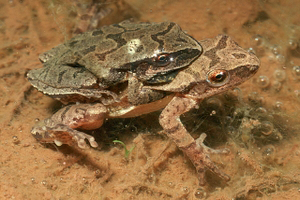In autumn, long after the breeding season, spring peepers regularly call from upland areas that are far from water. The significance of these nonbreeding vocalizations has not been clearly established.
Photo Credit: Geoffrey A. Hammerson
Pseudacris crucifer
Common Name: spring peeper
Animal Guild: Amphibian
Class > Order > Family: Amphibia > Anura > Hylidae
What does the species look like?
The upper side is gray, pink, brown, olive, or yellowish, usually with a dark figure more or less resembling an "X" (may be distorted or fragmented). A dark band runs from the snout to the eardrum, and a dark stripe extends across the head between the eyes. The hind toes are not distinctly webbed, and the toe tips are not greatly expanded. Maximum snout-vent length is around 1.5 inches (3.7 cm). Newly metamorphosed young are about 14 mm in snout-vent length. In mature males, the throat skin is loose and dark during the breeding season. The expanded vocal sac is rounded. Breeding calls consist of high single peeping whistles, with a slight rise at the end, repeated every second or so. Males also produce trilled whistles. A distant chorus of many frogs sounds like "sleigh bells." Larvae have tail fins of moderate height. The fins often have large dark blotches and a clear area near the tail muscles. The eyes of larvae are at the outer margin of the head when viewed from above. Larvae reach a total length up to around 1.4 inches (35 mm).
Where is the species found?
States & Provinces
AL, AR, CT, DC, DE, FL, GA, IA, IL, IN, KS, KY, LA, MA, MB, MD, ME, MI, MN, MO, MS, NB, NC, NH, NJ, NL, NS, NY, OH, OK, ON, PA, PE, QC, RI, SC, TN, TX, VA, VT, WI, WV
Distribution
Range extends throughout the eastern United States and adjacent southeastern Canada east to Labrador, west to Manitoba, Minnesota, Iowa, eastern Kansas, Oklahoma, and eastern Texas, south to the Gulf Coast and northern Florida.
Spring peepers inhabit moist wooded areas near breeding pools. They are mostly ground dwelling, and they hide under logs, rocks, or other objects when not active on the surface, such as during the cold winter months in the north. Eggs are laid and larvae develop in small temporary or permanent waters of ponds (including those in fields with nearby forest), marshes, ditches, and swamps, especially those with standing plants, sticks, or other debris. Males call from among vegetation adjacent to or standing in water, or while perched low in woody vegetation away from water.
General Phenology and Life History
Peepers are most active at dusk and at night but are also active diurnally, especially in wet weather. The breeding season is in early spring in the northern part of the range but may occur in fall, winter, or early spring in the south. Adult females lay up to several hundred eggs (deposited singly on submerged vegetation or other objects). Eggs hatch in a few to several days. Larvae metamorphose in 2-4 months.
Which phenophases should I observe?
Do you see/hear...?
Activity
Adults on land More...
For abundance, enter the number of individual animals observed in this phenophase.
Adults in water More...
For abundance, enter the number of individual animals observed in this phenophase.
Adults feeding For abundance, enter the number of individual animals observed in this phenophase.
Reproduction
Vocalizing What is the intensity of vocalizing?
Single calls: There is space between calls and individuals can be counted. Overlapping calls: Calls of individuals can be distinguished but there is some overlapping of calls. Full chorus: Calls are constant and overlapping.
Mating For abundance, enter the number of individual animals observed in this phenophase.
Fresh eggs For abundance, enter the number of individual animals observed in this phenophase.
Development
Dead adults For abundance, enter the number of individual animals observed in this phenophase.
What do these phenophases look like?
There is currently no photoguide available for this species. If you'd like help us create one, use the guidance document and species template provided here . Then send it via email to education@usanpn.org when it is complete.
